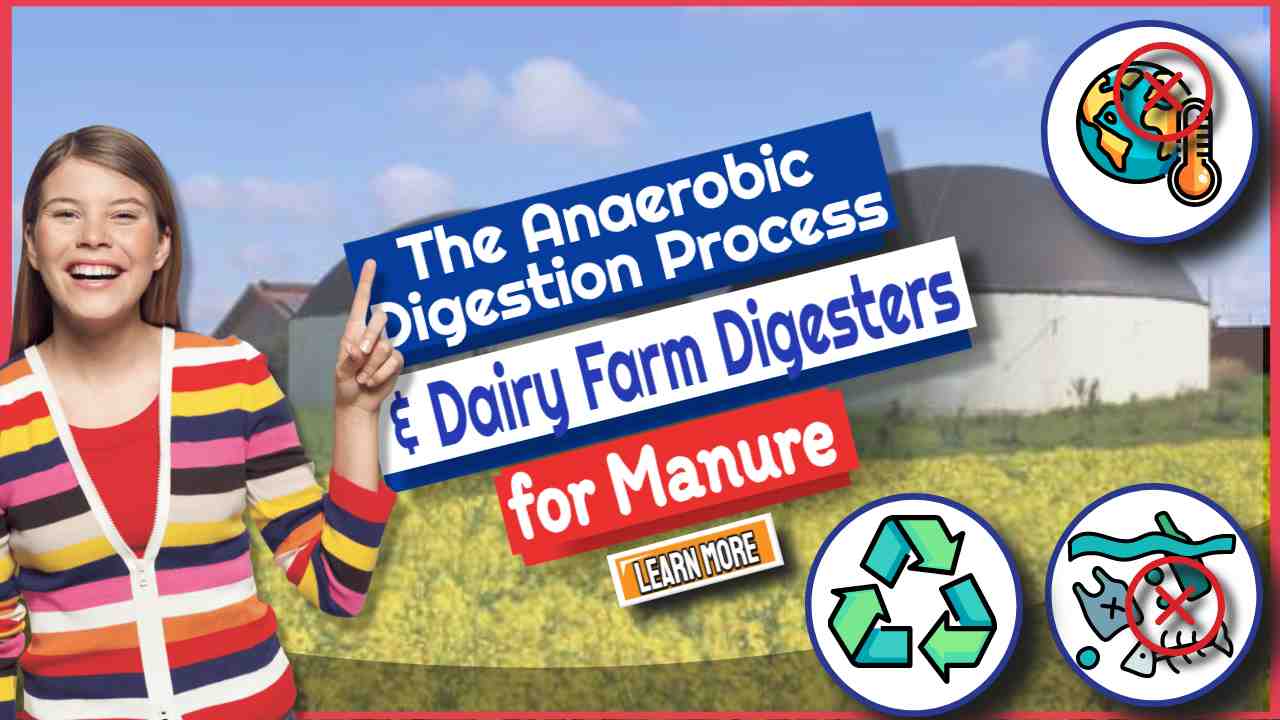The subject of the anaerobic digestion process and dairy farm digesters for manure management might seem a bizarre subject for this website. But this topic, while still new to most people, is about to become a mainstream business for thousands of astute dairy farmers in the US.
The fact is that many investors are looking for sustainable businesses to invest in, to protect their children from climate change misery. Plus, the not inconsiderable fact that “green” businesses are currently performing very well on the stock exchange. Add to that US government policy on reducing food waste which, as a last resort, farm digesters can easily process in their digesters. And, suddenly, you have:
- a profitable sideline for farmers, and
- an investment opportunity for specialist financiers looking to invest to take Dairy AD and food waste co-disposal to a whole new level.
So read on, and remember that you heard about it here first!
The Anaerobic Digestion Process
Anaerobic digestion is a biochemical conversion process used for the treatment and mass reduction of organic wastes including solids, such as organic sewage sludge or concentrated biowaste from industry. In the absence of oxygen, bacteria break down biodegradable material. Anaerobic digestion is used in industry and at home to manage waste and create fuel (i. e. Renewable Natural Gas).
Fermentation is a term that most people are acquainted with. Fermentation is only a subset of the anaerobic digesting process. It is utilised in the industrial production of food and beverage goods, as well as in the brewing of alcoholic beverages.
Background to Anaerobic Digestion in Dairy Farms
Anaerobic digestion offers several environmental and economic benefits. The key aspect is that it generates renewable energy in the form of methane, which is a renewable energy source. Because of this, the number of dairy farm anaerobic waste digesters in the United States has steadily increased in the last few years.
Previously, cow dung was simply dumped into a stagnant, stinky lagoon, where it waited until dry weather before being distributed on the fields. While it was resting there, the emission of biogas (produced by the natural anaerobic digestion process) was spontaneously occurring. This occurs frequently prior to the manure slurry being pushed out onto the fields. But, methane emissions are about 30 times more warming than carbon dioxide. So, if mankind is going to hold the planet to no more than a 1.5-degree average temperature rise, governments need to tackle agricultural methane emissions through far better manure management.
In other words, naturally occurring microorganisms convert the slurry lagoons (present on all dairy farms that do not have a biogas facility) to methane gas. And, because of the amount of global warming methane generated, this is quite dangerous. This is because methane is a greenhouse gas that is 25 to 35 times more effective than carbon dioxide in trapping the sun's heat in our atmosphere.
The Dairy Farm Community Biogas Refinery Concept
A typical dairy waste-to-energy plant is made up of many farms totalling 2,000 to 3,000 dairy cows. The methane generated by dairy manure is caught via anaerobic digestion and transferred to a central conditioning plant via low-pressure collecting lines. After the gas has been treated and cleansed of contaminants, it is sent to local customers via the existing subterranean natural gas distribution network.
As previously stated, anaerobic digestion involves the bacterial breakdown of organic materials in the absence of oxygen, which results in the production of biogas in four stages.
Reducing the Carbon Footprint of Milk Production
Running an anaerobic digestion process plant that uses manure to feed biogas production is one of several steps that the agriculture industry will need to do to minimise the carbon footprint of milk production.
This method eliminates a significant part of the volatile solids (VS) from manure, lowering the potential for methane and carbon dioxide emissions during storage and subsequent land application. The biogas generated can be used to create power, or it can be further purified and utilised as a low-emission car fuel, or it can even be injected into the natural gas infrastructure.
In some regions of the United States, the management of residual flows from swine farms, such as slurry and hydrolyzate, is also a major environmental concern.
It is critical to look for creative solutions to river and even aquifer contamination caused by extensive livestock operations. It is also preferable if they can be applied on-site, reducing waste transportation. Anaerobic co-digestion can be used to provide a long-term strategy of managing and valorizing these fluxes in dairy and swine farms. The installation of a biodigester yields biogas for energy production as well as digestate with agronomic use.
What is a biogas system?
Anaerobic digestion is used in biogas systems to recycle organic waste, converting it into biogas, energy (the gas), and valuable soil products (liquids and solids) through a natural, biological process. Following easy processing, biogas becomes a sustainable replacement for natural gas, while the digested materials—liquids and solids—can be converted into a broad range of valuable soil products, including:
- a peat-moss horticultural compost replacement,
- a liquid fertilizer product, and even
- a fibre suitable for sale as livestock bedding.
The generation of biogas from grass is also a proven practical technique. Farmers with excess grass not needed for overwintering stock can digest their silage for even more biogas output.
Today, many UK dairy producers have not only contemplated a change to their business but have already sold their herds!
Instead of milking cattle, they cultivate grass for direct feed into an anaerobic digestion facility and store silage for winter usage. This makes sense in rainy parts of the United Kingdom and Ireland, where grass grows exceptionally well. Producing most other crops effectively on their land is difficult due to:
- repeated late frosts,
- a cold, rainy, and windy environment, and
- the unreliability of dry weather and sunshine when needed to mature the crop and enable harvesting to take place.
Although anaerobic digestion (AD) can prevent large amounts of methane, a powerful greenhouse gas (GHG), from being emitted into the environment it also reduces pollution of the water environment around farms. It reduces nitrate build-up from high-intensity farming and provides natural fertiliser which can reduce the cost of bought-in fertilizer significantly
When all of the climate advantages of AD are considered with other emissions reductions the process starts to look like a no-brainer for Dairy Farm businesses.
According to AD Company Brightmark, RNG (Renewable Natural Gas) generation from dairy manure may cut GHG emissions by 400% when utilised to replace traditional vehicle fuels through this net carbon-negative process.
Dairy Manure Slurry the Ever Present Waste in Dairy Farming
Dairy manure is a common waste in dairy production, and it presents a number of storage, management, and disposal difficulties. We've already explained how unless manure management is prioritised, dairy manure emits foul odours, harmful ammonia, and greenhouse gases that contribute to global warming.
Never forget, though, that dairy manure digesters always have a relatively modest biogas production per unit mass. When compared to, say, food waste digestion, it is extremely low. As a result, using manure to create biogas might be comparably expensive in terms of cost per unit volume produced.
The practical use for controlling waste and the overall fit within the dairy business are what make a biogas system desirable to dairy producers who embrace the method by co-digestion with food waste. Adding the food waste balances up a digester and makes it perform much better as the energy stored in food is the highest of any feedstock source. If ever there was a time when you can get a quart out of a pint pot, it is when you add food waste into a manure digester!
Anaerobic digestion may also be set up in a way that removes odours by digesting the manure. Adding food waste also improves the nutritional value of the digestate when applied to fields, resulting in a better soil amendment.
In a big new project in Buckinghamshire, UK, prominent dairy cooperative Arla has been converting cow dung into a form of “vehicle-friendly gasoline”. Farmers will transport their cow dung to a new local anaerobic digestion (AD) facility under Arla's proposal. It will be broken down into pure biomethane and turned into fuel while there. According to the company, the pilot will one day make Arla the first dairy in the UK to use agricultural waste to produce biomethane to fuel its distribution fleet of HGVs.
How Many US Anaerobic Digesters are Working?
Anaerobic digestion systems for dairy farms are becoming increasingly popular in the United States.
In July 2010, the EPA reported that 157 commercial digester plants were in operation across the country. Of the 157 digesters, 22 were in New York state, making it the second most active digester state in the country.
As a result of growth in the number of AD plants, New York State now has more than 50 digesters, with more in the planning and implementation stages.
The Anaerobic Digester System
There were 52 manure-based AD systems alone in the United States producing RNG, in March 2021 according to the US EPA.
These comprise both pipeline injection and compressed natural gas (CNG) projects. There are also 44 RNG projects under development, according to reports (Source: EPA Agstar Livestock Anaerobic Digester Database). A map of all landfill and anaerobic digester-based RNG projects in the United States may be seen on the EPA RNG website.
The biogas digester is the system component into which animal, human, and other organic wastes are fed to break down anaerobically, generally as a slurry with water. A storage container is used to retain the generated gas, which is then piped for further usage as fuel. Variable volume storage (e.g., a flexible bag or floating drum) is simpler, less expensive, and potentially more energy-efficient than high-pressure cylinders, regulators, or compressors.
To function properly, anaerobic digestion needs continual monitoring and frequent adjustments to equipment settings. Regular laboratory testing on the substrate (contents of each digester's reactor tank) should be performed in all commercial AD process facilities. The tests are meant to look at the physical properties of the manure fed in, the substrate inside the bioreactor tank (COD, per cent solids, ph, and other key parameters), and the digestate output. All of these must be measured and used to take remedial action as soon as problems are discovered.
The wastewater goes into a covered manure pit through an overflow pipe. The processed manure's organic content is decreased and stabilised, resulting in a virtually odourless, homogenised liquid that does not attract rats or flies.
Only a small portion of the manure is turned to biogas during the AD process. Dairy cow dung is composed of around 85 per cent water and 15 per cent solids. Approximately 91 per cent of these solids are volatile.
One Penn State digester converts 20 to 30% of the volatile solids to biogas, which is typical of most biogas systems. The goal of this Penn State digester project was to promote green technologies and zero waste ideas in animal production. Furthermore, the operator intends to reduce negative environmental consequences.
In 2017, dairy farms housed 203 of the estimated 248 biogas producers active in the United States (Source: U. S. Environmental Protection Agency [EPA], 2017 ).
The Importance of Biogas
In comparison to the worldwide biogas capacity of 15 gw in 2015, the EU is the world leader in biogas energy production, with more than 10 gw installed and 17,400 biogas plants.
One of the recommended steps for the dairy sector to decrease its carbon footprint is the use of anaerobic digesters to absorb methane and convert it to renewable energy. Various efforts around the country are continuing to drive the expansion of biogas plants.
Farm operations in the United States and Europe have changed dramatically in recent decades: small farms are vanishing, while farm size and total animals on bigger farms are growing. The increased spatial density of animals has a number of environmental consequences. Anaerobic digestion is one potential technical option for mitigating the majority of these effects while also providing a regional energy source.
The economic feasibility of utilising dairy-cow dung for either:
- on-farm generation and use of biogas to generate power and heat or
- upgrading biogas to biomethane, a natural-gas alternative,
is assessed in this article.
Cows, with their four-chambered stomachs, have traditionally been models of digestive prowess, as anybody who has avoided cow pies in a field will attest.
Every day, these grazing bovines and other cattle create thousands of pounds of excrement. Energy conservation and organic farming, along with concern for animal waste management, has reignited interest in producing biogas from livestock manure. Two major efforts using anaerobic digester clusters have piqued the interest of dairy producers across the country.
When the US biogas plant construction is completed, this network of dairy biogas plants may be the world's largest system of its sort.
BioGas Generation with Dairy Manure?
Cow dung is converted into biogas using anaerobic digesters. Biogas, like natural gas, is mainly methane, thus it may be used to generate energy and power cars.
Renewable natural gas may be produced using biogas recovery systems in livestock farms. To stabilise and maximise methane production, animal dung is collected and supplied to an anaerobic digester. The biogas produced may be converted into rng and utilised to power natural gas vehicles.
The capital required to build a digester will vary greatly depending on the digester design, size, and equipment used for biogas usage and/or separation of manure fibre. The current capital cost range for full digester systems is $1,000 to $2,000 per cow, depending on herd size, with the cost of maintaining an engine generator set at $0. 015 to $0. 02/kWh of power generated.
Anaerobic Digestion of Dairy Manure in the US
Dairy digesters are a sustainable technology that utilises animal dung to create methane, a renewable source of electrical energy and transportation fuel. The technique offers several environmental and social advantages. The USEPA Agstar anaerobic digestion webpage has further information on dairy digesters.
On dairy farms, it is fairly unusual for a substantial volume of milk from milking operations to be released to manure digesters. Anaerobic digestion of animal dung has the ability to inactivate enteric pathogens, decreasing exposures to livestock and humans when the digested products are disposed of by land-spreading or irrigation, or returned to livestock uses such as bedding.
Anaerobic Digestion of transport fuel or production of electricity?
Anaerobic digestion (AD) of animal dung is an efficient process for converting undigested plant carbon to methane for use as a transportation fuel or in the generation of power.
While AD is most generally linked with dairy farming, the process is also used in swine and poultry farms to control manure and wastewater. Anaerobic digesters are characterised as passive, low-rate, or high-rate systems. Ad is a feasible GHG emission mitigation technique for dairy and swine farms due to the potential decrease of greenhouse gases (GHG) and the economic benefits of obtaining renewable energy from anaerobic digestion.
Energy-related expenditures may account for up to 29 per cent of overall farm operating costs, and the ongoing rise in the actual cost of energy-related farm input has been one of the primary factors influencing agricultural output costs. However, in order to be economically and environmentally sustainable, agriculture has the potential to replace some of the purchased energy in the form of fossil fuels, commercial fertiliser, and field production of animal feed with bioenergy and organic fertiliser from onsite renewable biomass such as animal manure.
The anaerobic method does not decrease nutrients. On-farm anaerobic digestion of dairy manure is being utilised to generate electricity and reduce odours. During the digestive process, acidogenic bacteria convert much of the organic matter in manure to volatile fatty acids (VFAs), which are subsequently eaten by methanogenic bacteria to generate methane, carbon dioxide, and a few other gases. These microbial activities convert nitrogen, phosphorus, and potassium, but these nutrients are not eliminated.






No responses yet